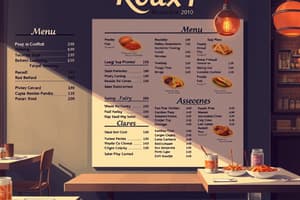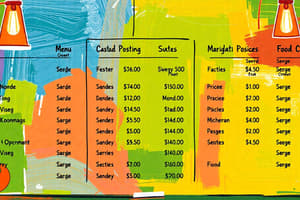Podcast
Questions and Answers
Which of the following is an example of a variable cost?
Which of the following is an example of a variable cost?
- Salaries
- Insurance
- Rent
- Hourly wages (correct)
Which of the following is an example of a fixed cost?
Which of the following is an example of a fixed cost?
- Commissions
- Cost of goods sold
- Salaries (correct)
- Hourly wages
What is gross profit?
What is gross profit?
- Revenue after taxes are paid
- The money remaining from sales after food and beverage costs are paid (correct)
- Revenue after all expenses are paid
- The total revenue generated by a company
Why is it risky to set menu prices by matching competitors' prices?
Why is it risky to set menu prices by matching competitors' prices?
Noncommercial operations, such as schools and corporate cafeterias, typically employ which pricing method?
Noncommercial operations, such as schools and corporate cafeterias, typically employ which pricing method?
Flashcards
Variable Cost
Variable Cost
Costs that change with the level of production or sales, such as hourly wages paid to staff.
Fixed Cost
Fixed Cost
Costs that remain constant regardless of the level of production or sales, such as employee salaries.
Gross Profit
Gross Profit
Revenue remaining after subtracting the cost of goods sold (food and beverage costs).
Matching Competitors' Prices
Matching Competitors' Prices
Signup and view all the flashcards
Table d'hote Menu Pricing
Table d'hote Menu Pricing
Signup and view all the flashcards
Study Notes
- Hourly wages are an example of a variable cost.
- Salaries are an example of a fixed cost.
- Gross profit is the money remaining from sales after food and beverage costs are paid.
- A dish that must sell for $4.95 at a food cost percentage of 30%, using the base price method, has a food cost of $1.49.
- Setting menu prices by matching competitors' prices is risky because the menu planner doesn't know the competitor's costs.
- The base price method is a pricing method that will not calculate a sales price.
- $5.01 is not a price that is typically comfortable for customers
- A high-end restaurant can communicate luxury to its customers by pricing a steak at $21.
- A table d'hote menu's sales price is calculated using the entrée cost and Q factor.
- Noncommercial operations, like schools and corporate cafeterias, typically employ the base price method.
- An all-you-can-eat buffet bases its sales price on average food cost per customer.
- The tone of the menu description should match the concept of the business.
- If a dish is listed as "Stir-fried Eggplant over Rice" and all ingredients are part of the recipe, shrimp paste should be listed in the menu description.
Studying That Suits You
Use AI to generate personalized quizzes and flashcards to suit your learning preferences.




